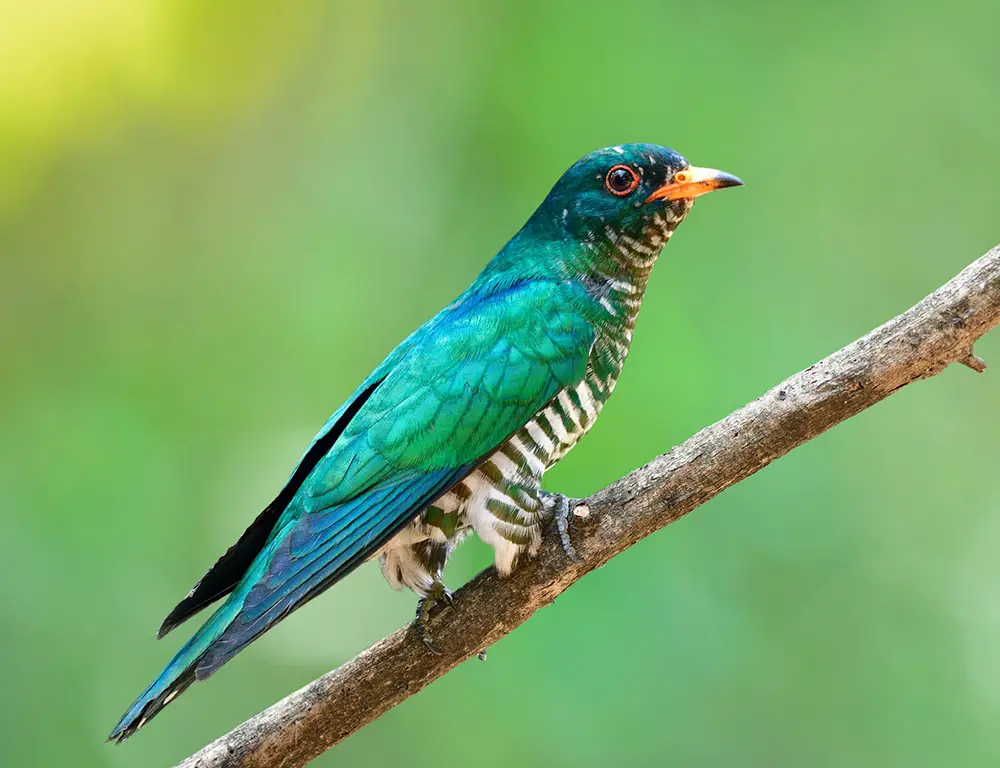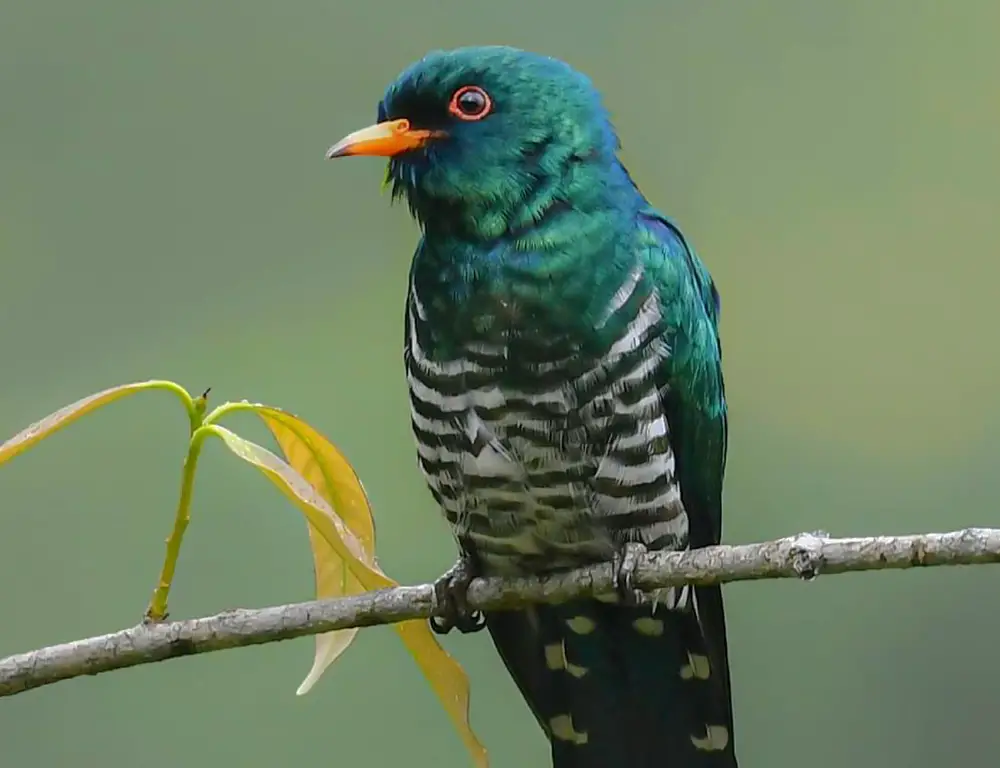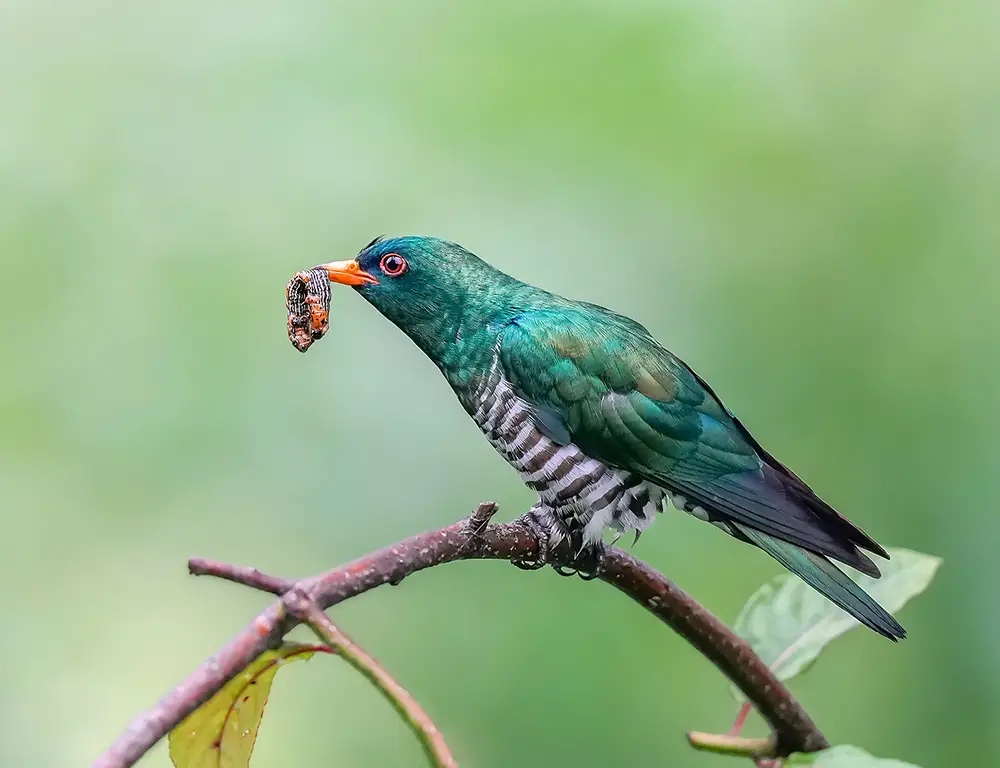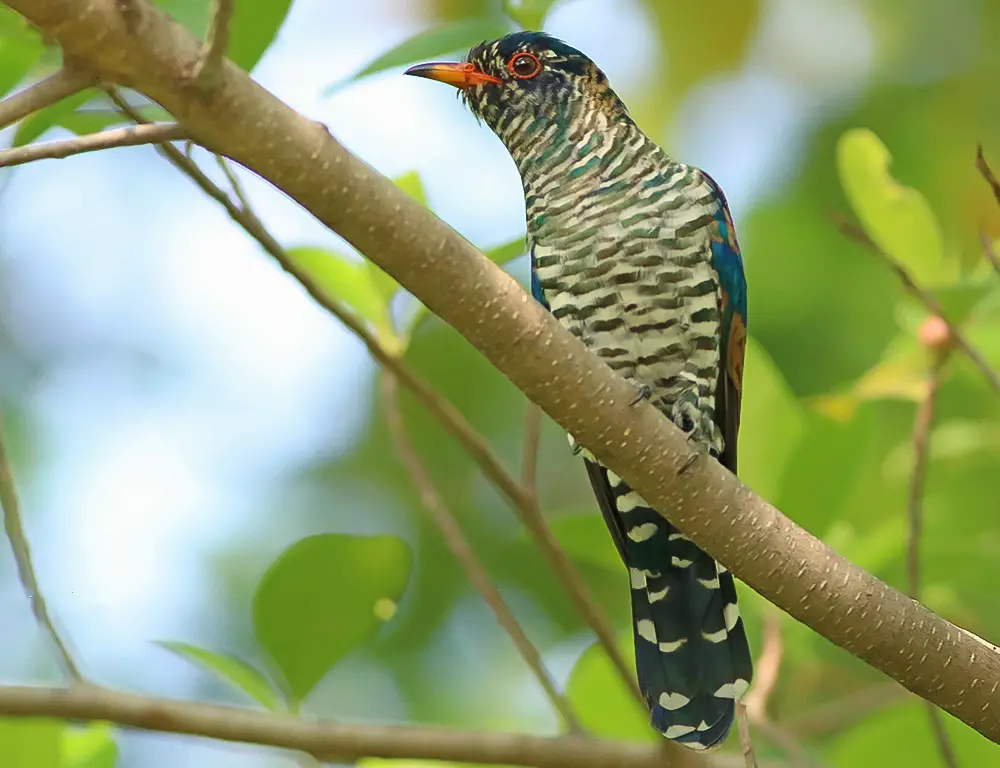Enthralling and glorious, the Asian Emerald Cuckoo stands as a beacon of fascination in the dense tapestry of Southeast Asia’s rainforests.
With its vibrant emerald green plumage, this diminutive yet captivating bird effortlessly captures the attention of any observer fortunate enough to behold its beauty.
Beyond its striking appearance lies a remarkable tale of survival and adaptation, underscored by its distinctive breeding behavior as a brood parasite.
These birds, scientifically known as Chrysococcyx maculatus, weave a narrative of intrigue with their melodious calls and unique ecological role.
In this exploration, we embark on a journey to unravel the mysteries of the Asian Emerald Cuckoo, delving into its habits, habitat preferences, and conservation status to deepen our understanding and appreciation of this remarkable species’ place within the intricate web of biodiversity.
Physical Characteristics of the Asian Emerald Cuckoo

The Asian Emerald Cuckoo (Chrysococcyx maculatus) is a small yet striking bird species native to Southeast Asia, known for its vibrant plumage and unique physical characteristics.
Here’s a detailed overview of its fundamental physical attributes:
Plumage
The most distinctive feature of the Asian Emerald Cuckoo is its radiant emerald-green plumage, which gives the bird its name.
Male Asian Emerald Cuckoos typically exhibit a brilliant green coloration on their upperparts, including the head, back, and wings, while their underparts are adorned with a contrasting white color.
In contrast, females have a more subdued coloration, with shades of green and grayish-brown tones on their bodies.
Size and Shape
Asian Emerald Cuckoos are relatively small birds, measuring around 17 to 20 centimeters (6.7 to 7.9 inches) in length from beak to tail.
They have a compact and agile body structure, with short wings and a streamlined shape ideal for maneuvering through dense forest canopies.
Their short legs and feet are adapted for perching on branches and hopping between foliage while foraging for food.
Sexual Dimorphism
There is noticeable sexual dimorphism in the plumage of Asian Emerald Cuckoos. Males typically display more vivid and intense green coloration, especially during the breeding season, while females have a slightly duller appearance with less vibrant colors.
This difference in plumage helps distinguish between males and females, although both sexes share similar body proportions and physical features.
Juvenile Plumage
Juvenile Asian Emerald Cuckoos have a different plumage coloration than adults. When they hatch, juveniles are covered in soft brown feathers, providing camouflage and protection from predators.
As they mature, their plumage gradually transitions to adult colors, with males developing the striking emerald-green plumage characteristic of the species.
Habitat and Distribution of the Asian Emerald Cuckoo

The Asian Emerald Cuckoo is primarily found in the lush forests of Southeast Asia, where its habitat preferences and distribution are closely tied to the region’s diverse ecosystems. Here’s an overview:
Habitat
Asian Emerald Cuckoos inhabit dense tropical rainforests with towering trees, thick foliage, and rich biodiversity. They are well-adapted to these environments, where they can blend into the greenery while foraging for food and nesting.
These birds are often found in areas with dense vegetation and ample insect prey, which are essential for their survival.
Distribution
The distribution of Asian Emerald Cuckoos spans several countries in Southeast Asia. They are commonly sighted in regions such as Thailand, Vietnam, Cambodia, Laos, Myanmar, and parts of southern China.
Within these countries, they occupy various forested landscapes, including lowland rainforests, montane forests, and wooded foothills.
Altitudinal Range
While primarily dwelling in lowland rainforests, Asian Emerald Cuckoos can also be found at higher elevations. They are typically observed between 600 to 1,300 meters above sea level altitudes.
This altitudinal range provides them access to diverse habitats and ensures a steady supply of insect prey throughout their range.
Migration
While some populations of Asian Emerald Cuckoos are resident year-round in their habitats, others exhibit migratory behavior.
During colder months or periods of food scarcity, migratory individuals may move to warmer regions within Southeast Asia or even travel further south to areas like Australia.
Migration patterns can vary among individuals and populations, influenced by food availability and climatic conditions.
Behavior and Diet of the Asian Emerald Cuckoo

The behavior and diet of the Asian Emerald Cuckoo are fascinating aspects of its ecology, reflecting its unique adaptations and role within its ecosystem. Here’s an overview:
Breeding Behavior
One of the most intriguing aspects of the Asian Emerald Cuckoo’s behavior is its breeding strategy, which involves brood parasitism.
Instead of building their nests, female cuckoos lay their eggs in the nests of other bird species, known as hosts.
They carefully select suitable host nests from smaller bird species, such as warblers or flycatchers. Once the cuckoo egg is deposited in the host nest, the unsuspecting host parents raise the cuckoo chick alongside their offspring.
This strategy allows the Asian Emerald Cuckoo to exploit the parental care provided by other bird species.
Feeding Habits
Asian Emerald Cuckoos are primarily insectivorous, with a diet consisting mainly of insects and caterpillars.
They are skilled hunters, capable of catching flying insects mid-air or picking prey off leaves and branches during flight. Their agile flight and keen vision enable them to locate and capture prey precisely.
In addition to insects, they may consume spiders and small fruits when prey is scarce. Their high-protein diet provides the energy necessary for their active lifestyle, including foraging and breeding.
Foraging Behavior
Asian Emerald Cuckoos are often observed foraging within the dense foliage of their forest habitat. They move swiftly through the canopy, using their slender bodies and short legs to navigate branches and foliage.
Their keen eyesight and agility allow them to efficiently locate and capture insect prey. They may dart after flying insects or glean prey from leaves and vegetation, demonstrating their adaptability to different foraging techniques.
Communication
While not extensively studied, Asian Emerald Cuckoos are known to vocalize, particularly during the breeding season. Their calls are described as melodic and may serve purposes such as mate attraction or territory defense.
These vocalizations contribute to the rich tapestry of sounds within their forest habitat and may play a role in communication between individuals.
Conservation Status of the Asian Emerald Cuckoo

The conservation status of the Asian Emerald Cuckoo is currently categorized as “Least Concern” by the International Union for Conservation of Nature (IUCN) Red List.
While this designation may initially suggest that the species is not facing immediate threats of extinction, it’s essential to delve deeper into the factors influencing its conservation status and the potential risks it may encounter. Here’s a closer look:
Habitat Loss
One of the primary threats to the Asian Emerald Cuckoo is habitat loss and degradation due to deforestation.
The extensive clearing of forests for agriculture, urbanization, and infrastructure development poses a significant risk to the bird’s natural habitat.
As forests diminish, the suitable habitat for Asian Emerald Cuckoos becomes fragmented, reducing population sizes and limiting foraging and breeding opportunities.
Climate Change
Climate change is another factor that could impact the Asian Emerald Cuckoo and its habitat. Changes in temperature, precipitation patterns, and weather extremes may alter the availability of food resources, disrupt breeding cycles, and affect migration patterns.
Additionally, rising temperatures could lead to shifts in the distribution of suitable habitats, further exacerbating habitat loss and fragmentation.
Human Disturbance
Human activities such as logging, agricultural expansion, and infrastructure development can directly disturb Asian Emerald Cuckoos and their nesting sites.
Increased human presence in forested areas may also lead to disturbances, including noise pollution and habitat degradation, which can negatively impact breeding success and overall population health.
Conservation Efforts
While the Asian Emerald Cuckoo is currently listed as “Least Concern,” proactive conservation efforts are still necessary to ensure its long-term survival.
These efforts may include habitat conservation and restoration initiatives, protected area management, and community-based conservation programs that engage local communities in bird conservation and sustainable land use practices.
FAQs
What is the average lifespan of an Asian Emerald Cuckoo?
The average lifespan of an Asian Emerald Cuckoo in the wild ranges from 5 to 7 years, influenced by factors like predation and habitat conditions.
Do Asian Emerald Cuckoos migrate?
Some Asian Emerald Cuckoos exhibit migratory behavior, moving to warmer regions within Southeast Asia or further south to areas like Australia during colder months.
What are the predators of Asian Emerald Cuckoo eggs and chicks?
Predators of Asian Emerald Cuckoo eggs and chicks include snakes, birds of prey, and arboreal mammals such as tree-climbing predators.
How do Asian Emerald Cuckoos communicate with each other?
Asian Emerald Cuckoos communicate through melodic calls and alarm calls, which serve purposes such as mate attraction, territory defense, and communication between individuals.
What role do Asian Emerald Cuckoos play in their ecosystems?
Asian Emerald Cuckoos play a crucial role as insect predators, helping to regulate insect populations and potentially contributing to seed dispersal through fruit consumption.
Conclusion
The Asian Emerald Cuckoo is a captivating symbol of nature’s beauty and resilience. Its vibrant plumage, melodic song, and unique behaviors like brood parasitism captivates our imagination and underscores the delicate balance of ecosystems.
However, looming threats like deforestation pose significant risks to its habitat and population. The decline of these birds underscores the broader consequences of human actions on biodiversity. Yet, it also presents an opportunity for collective action and conservation efforts.
By supporting initiatives to preserve their habitats and raising awareness about the importance of environmental stewardship, we can safeguard the Asian Emerald Cuckoo and ensure its continued presence in the intricate tapestry of Asia’s forests.